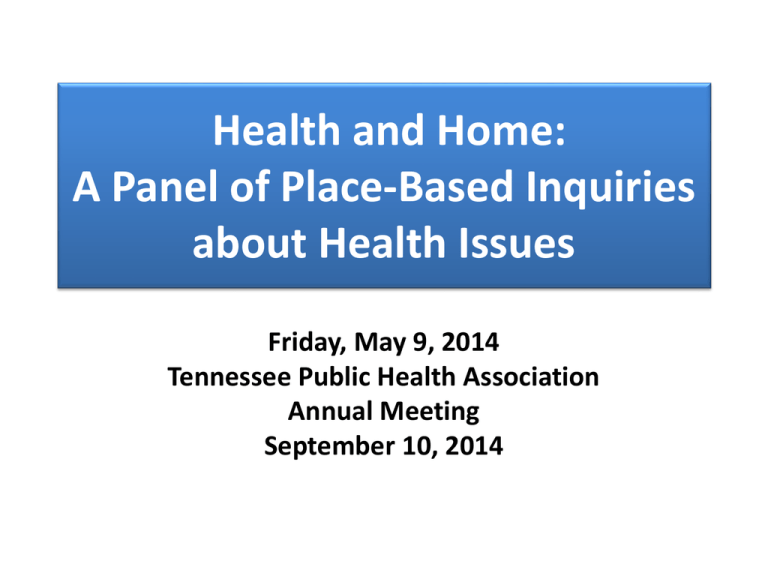Place based Session - Tennessee Public Health Association
advertisement

Health and Home: A Panel of Place-Based Inquiries about Health Issues Friday, May 9, 2014 Tennessee Public Health Association Annual Meeting September 10, 2014 Learning Objectives • To describe purposes, use and key points about blending quantitative and qualitative methods to describe place-based population health issues • To describe three examples of placed-based population health issues inquiry • To discuss findings and summarize key principles Our Process • Follow TPHA annual theme • Regional sessions with examples “from the field” • Invited proposals for presentation at annual meeting panel • TPHA committee selection of best presentations Many health conditions are influenced by place Think about differences in risk, morbidity (illness) and mortality (death) Use assessment methods to explore, document, and describe the condition Many health conditions are influenced by place Think about differences in risk, morbidity (illness) and mortality (death) Quantitative data Qualitative approaches Identify types of numbers (rates, percentages, counts) that would help to verify placebased differences Select some questions and methods used to collect “stories” about why the differences may exist Use assessment methods to explore, document, and describe the condition Questions to Consider • What makes the places in the three case different? – The communities and patients – The health services and systems – The interaction between them • How do presenters identify – The numbers? – The stories? • What can we learn from three cases about influence of place on health? One more case: Appalachia: Where Place Matters • Qualitative studies in TN, KY and VA • Why cancer mortality rates higher where incidence rates lower • Finding: it’s the mix of population, health services and place – Education levels - That people don’t know about cancer can hurt them – The tobacco heritage dilemma - Tobacco is risk factor but also a regional economic driver – The role of religion – Seen as fatalism or comforting factor? – Rural - Low population density affects service availability – Trust of healthcare - communication is the pivotal factor Behringer B and Friedell GH. (2006). Appalachia: Where place matters in health. Preventing Chronic Disease [serial online] October. Available from: http://www.cdc.gov/pcd/issues/2006/oct/06_0067.htm. Place-based influences on health: Two ways to explore any health issue Quantitative (Numbers) • Compare risk, morbidity and mortality rates with others • Units of analysis: state, regions, counties, cities, neighborhoods • Many sources and layers of data to tap • Epidemiology strategies Qualitative (Stories) • Getting behind the numbers • Use mix of approaches: community meetings, panels of experts (focus groups), surveys/interviews • Community/patient engagement strategies • “Am I asking the right questions?” Useful approach: Start with the numbers and use qualitative methods to ask “why?” No numbers without stories, no stories without numbers!











